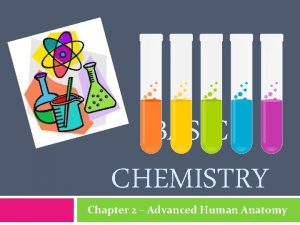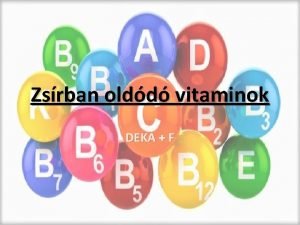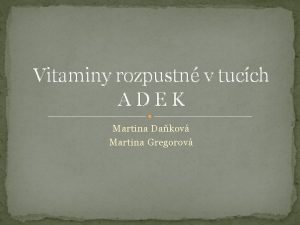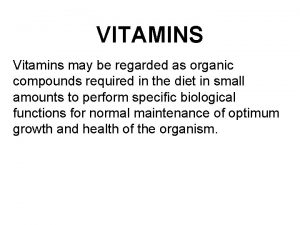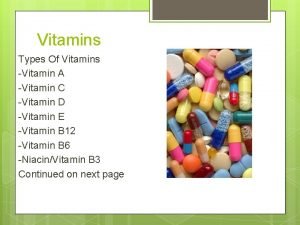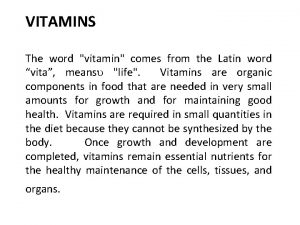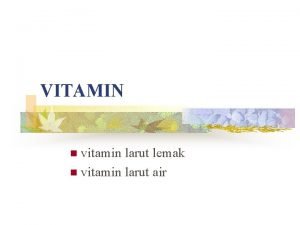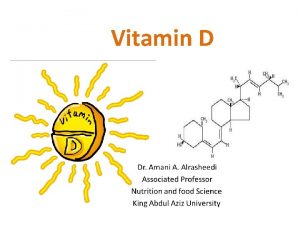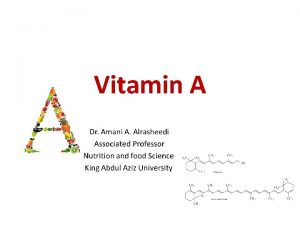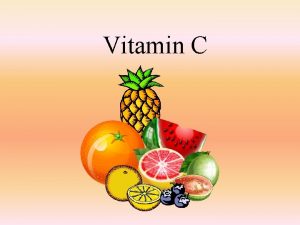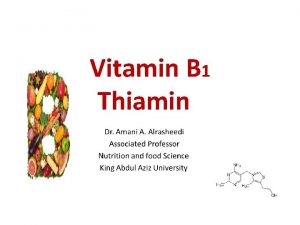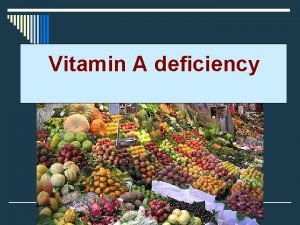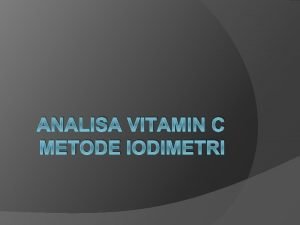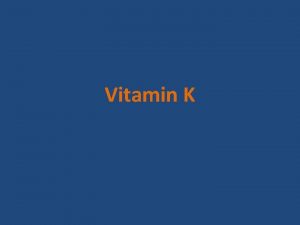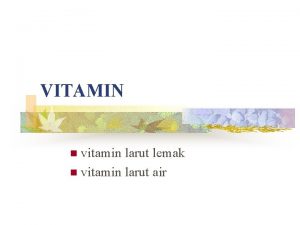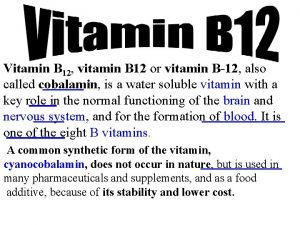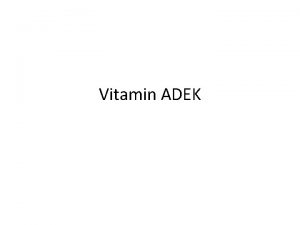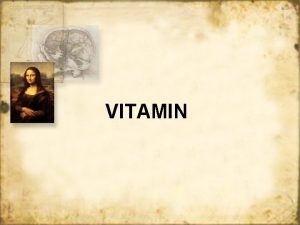Vitamin E refers to a group of eight






















- Slides: 22

Vitamin E refers to a group of eight fat-soluble compounds that include both tocopherol and tocotrienol. The vitamin is synthesized by plants, and has eight different isoforms (Vitamers) divided into two classes of four Vitamers each.



• α-Tocopherol • α-Tocopherol is an important lipid-soluble antioxidant. • It performs its functions as antioxidant by the glutathione peroxidase pathway and it protects cell membranes from oxidation by reacting with lipid radicals produced in the lipid peroxidation chain reaction. • This would remove the free radical intermediates and prevent the oxidation reaction from continuing.

• Tocotrienol are members of the vitamin E family. The slight difference between tocotrienol and tocopherol lie in the unsaturated side chain having three double bonds in its farnesyl isoprenoid tail.

• Comparison of Tocotrienol and Tocopherol • Tocotrienol are forms of natural vitamin E that can protect against brain cell damage, prevent cancer and reduce cholesterol. • These biological characteristics, however, are not present in tocopherol due to their chemical structure. • The unsaturated side-chain in tocotrienol causes them to penetrate tissues with saturated fatty layers more efficiently making them ideal for anti-aging oral supplements and the skin care range. • Tocotrienol are better able than tocopherol at combating oxidative stress of skin that had been exposed to UV rays of the sunlight.


Why is the natural form of vitamin E better than the • synthetic form? The difference is: availability. • Natural vitamin E has roughly twice the availability of • synthetic vitamin E. There is a difference in the molecule, in its potency • and in the way it behaves in the body. The natural form, is a single entity, in other words all the molecules are identical. The synthetic dl-alpha-tocopherol is a mixture of 8 • different molecular entities, known as "stereoisomers". Of these 8, only 1 is identical to the natural form, the • other 7 do not exist in nature. .


• Sources The natural form of the vitamin is synthesized only • by plants and is found predominantly in plant oils. •

The plant chloroplast is the site of biosynthesis, and the aromatic amino acid tyrosine can be considered the basic precursor.

• Metabolism • Absorption of vitamin E is highly dependent upon the same processes that are utilized during fatty acid digestion and metabolism. Bile acids are considered essential for vitamin E absorption and micelle formation. Once formed, the micelle is then able to cross the unstirred water layer and release its contents into the enterocytes. After passing through the enterocytes the vitamin E is packaged into a chylomicron and readied for circulation.




• Storage • Vitamin E is a lipid soluble vitamin and therefore over 90% of total body vitamin E is found in the adipose tissue. • Excretion • Vitamin E is excreted mainly via bile, urine, feces, and the skin. • The vitamin is oxidized and forms hydroquinone and then is conjugated to form glucuronate. • Once formed the glucuronate can be excreted into bile or further degraded in the kidneys and excreted in the urine. Because of the poor intestinal absorption of vitamin E, fecal excretion is the main route of vitamin E elimination.

• • • Functions of vitamin E Vitamin E is integral part of cellular membranes whose main role is to defend the cell against oxidation. 1 -Antioxidant. 2 -Regulates oxidation reactions. 3 -Cell-membrane stability. 4 -Protect polyunsaturated fatty acids. The primary role of vitamin E within the body is to function as an antioxidant. Vitamin E is considered to be the major chain breaking antioxidant in membranes.

• Mechanism of action of antioxidants, vitamin E Free radicals, such as superoxide, hydroxyl ions and • nitric oxide all contain an unpaired electron. These radicals can have a negative effect on cells • causing oxidative damage that leads to cell death. Antioxidants, such as vitamin E due to its lipid solubility is particularly important in protecting cell membranes, prevent cell damage by binding to the free radical and neutralizing its unpaired electron. The resulting tocopherol radical is then reduced back • to tocopherol by glutathione, vitamin C or other molecules. Thus the free hydroxyl group on the aromatic ring is responsible for the antioxidant properties.



• Deficiency • A deficiency of vitamin E is rare in humans Vitamin E deficiency causes neurological problems due to poor nerve conduction. • Deficiency can also cause anemia due to oxidative damage to red blood cells, retinopathy and impairment of the immune response.

• The existence of a lack of vitamin E is rare. • If this occurs, it is manifested in specific cases, that is, in the following three situations: • 1 -Persons with a difficulty of absorbing or secreting bile or who suffer from fat metabolism-related disease (celiac disease or cystic fibrosis) • 2 -Premature infants (with Very low birth weight, VLB) who weigh <1, 500 grams at birth • 3 -Persons with genetic abnormalities in alphatocopherol transporter proteins.
 Plane shapes
Plane shapes A short section of corrugated roadway that warns of hazards
A short section of corrugated roadway that warns of hazards Culture refers to
Culture refers to Social loafing examples
Social loafing examples Y = a(b)^x
Y = a(b)^x Anova within group and between group
Anova within group and between group Primary group
Primary group Group 2 specialties
Group 2 specialties Thermal decomposition of group 1 nitrates
Thermal decomposition of group 1 nitrates Amino group and carboxyl group
Amino group and carboxyl group Amino group and carboxyl group
Amino group and carboxyl group In group out group
In group out group Group yourselves
Group yourselves Sumner's classification of social groups
Sumner's classification of social groups Joining together group theory and group skills
Joining together group theory and group skills Deka vitaminok
Deka vitaminok Longjax side effects
Longjax side effects Properties of vitamin b
Properties of vitamin b Vitaminli o'simliklar
Vitaminli o'simliklar Adek vitamin
Adek vitamin Biochemical functions of thiamine
Biochemical functions of thiamine Vitamin types
Vitamin types The word vitamin comes from
The word vitamin comes from










